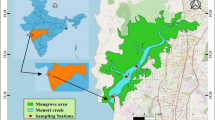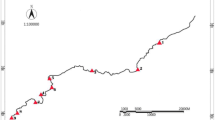Abstract
Phytoplankton and water samples were collected at 12 locations along the temperate lowland Rideau River, Ontario, Canada. The stations were visited twice a month from May to September 1998, 1999, and 2000. Phytoplankton communities were quantified based on cell abundance, entity abundance (colonies, filaments or free-living cells) and biomass (converted from biovolume estimates based on cell shape and biometry), and were expressed as absolute and relative values. The resulting phytoplankton dataset was composed of six different metrics. The general objective was to assess which metric best explained the spatial and temporal variability in the phytoplankton communities of the Rideau River in response to fluctuating environmental variables. Relationships between phytoplankton metrics and water quality variables were assessed using canonical correspondence analyses. The absolute cell abundance metric showed the best relationship with water quality, followed by the cell entity metric. The biomass metric showed the poorest relationship with water quality variables, indicating that accounting for cell size does not provide additional information. The data expressed as absolute values were consistently better predictors of water quality compared to relative values.
Similar content being viewed by others
References
Ansotegui A, Sarobe A, Trigueros JM,Urrutxurtu I, Orive E (2003) Size distribution of algal pigments and phytoplankton assemblages in a coastal—estuarine environment: contribution of small eukaryotic algae. J Plankton Res 25:341–355
Birks HJB (1995) Quantitative palaeoenvironmental reconstructions. In: Maddy D, Brew JJ (eds) Statistical modelling of quaternary science data. Quaternary Research Association, Cambridge, pp 161–254
Cermeño P, Marañon E, Rodríguez J, Fernández E (2005) Large-sized phytoplankton sustain higher carbonspecific photosynthesis than smaller cells in a coastal eutrophic ecosystem. Mar Ecol Prog Ser 297:51–60
Clarke KR, Gorley RN (2006) PRIMER v 6: user manual/tutorial. PRIMER-E Ltd., Plymouth, 190 pp
Coste M (1982) Étude des méthodes biologiques d'appréciation quantitative de la qualité des eaux. CEMAGREF, Bassin Rhône-Méditerranée-Corse, France
Cottingham KL (1999) Nutrients and zooplankton as multiple stressors of phytoplankton communities: Evidence from size structure. Limnol Oceanogr 44:810–827
del Giorgio PA, Vinocur AL, Lombardo RJ, Tell HG (1991) Progressive changes in the structure and dynamics of the phytoplankton community along a pollution gradient in a lowland river—a multivariate approach. Hydrobiologia 224:129–154
Devercelli M (2006) Phytoplankton of the middle Parana River during an anomalous hydrological period: a morphological and functional approach. Hydrobiologia 563:465–478
Gosselain V, Hamilton PB (2000) Algamica: revisions to a key-based computerized counting program for free-living, attached and benthic algae. Hydrobiologia 438:138–142
Gosselain V, Descy J-P, Everbecq E (1994) The phytoplankton community of the River Meuse, Belgium: seasonal dynamics (year 1992) and the possible incidence of zooplankton grazing. Hydrobiologia 289:179–191
Gosselain V, Viroux L, Descy J-P (1998) Can a community of small-bodied grazers control phytoplankton in rivers? Freshw Biol 39:9–24
Gosselain V, Hamilton PB, Descy J-P (2000) Estimating phytoplankton carbon from microscopic counts: an application for riverine systems. Hydrobiologia 438:75–90
Hamilton PB (1990) The revised edition of a computerized plankton counter for phytoplankton, periphyton and sediment diatom analyses. Hydrobiologia 194:23–30
Hamilton PB, Duthie HC (1984) Periphyton colonization of rock surfaces in a boreal forest stream studied by scanning electron microscope and track autoradiography. J Phycol 20:525–532
Hamilton PB, Proulx M, Earle C (2002) Enumerating phytoplankton with an upright compound microscope using a modified settling chamber. Hydrobiologia 444:171–175
Hasle GR (1978) Using the inverted microscope. In: Sournia A (ed) Phytoplankton manual. UNESCO, Paris, pp 191–196
Hillebrand H, Durselen CDD, Kirschtel U, Pollingher T, Zohary T (1999) Biovolume calculation for pelagic and benthic microalgae. J Phycol 35:403–424
Kamenir Y, Winder M, Dubinsky Z, Zohary T, Schladow G (2008) Lake Tahoe vs. Lake Kinneret phytoplankton: comparison of long-term taxonomic size structure consistemcy. Aquat Sci 70:195–203
Kiss KT, Ács É, Kovács A (1994) Ecological observation on Skeletonema potamus (Weber) Hasle in the River Danube, near Budapest (1991, 92 daily investigations). Hydrobiologia 289:163–170
Lavoie I, Campeau S, Grenier M, Dillon PJ (2006a) A diatom-based index for the biological assessment of eastern Canadian rivers: an application of correspondence analysis (CA). Can J Fish Aquat Sci 63:1793–1811
Lavoie I, Campeau S, Fallu M-A, Dillon PJ (2006b) Diatoms and biomonitoring: should the cell size be accounted for? Hydrobiologia 573:1–16
Lavoie I, Dillon PJ, Campeau S (2009) The effect of excluding diatom taxa and reducing taxonomic resolution on multivariate analysis and stream bioassessment. Ecol Indic 9:213–225
Lavoie I, Lento J, Morin A (2010) Inadequacy of size distributions of stream benthic diatoms for environmental monitoring. J North Am Benthol Soc 29:586–601
Lund JWG, Kipling C, Le Cren ED (1958) The inverted microscope method of estimating algal numbers and the statistical basis of estimating counting. Hydrobiologia 11:143–170
OME (Ontario Ministry of the Environment) (1994) Water management: policies, guidelines, provincial water quality objectives of the Ministry of the Environment. Document accessed from the OME Internet site (http://www.ene.gov.on.ca/envision/gp/3303e.pdf)
Passy S (2001) Spatial paradigms of lotic diatom distribution: a landscape ecology perspective. J Phycol 37:370–378
Patrick R (1965) Algae as indicators of pollution. In: U.S. Department of Health, Education and Welfare, Biological Problems in Water Pollution. Cincinnati, Ohio PHS Publication 999-WP-25, pp 225–231
Perez-Ruzafa A, Gilabert J, Gutierrez JM, Fernandez AI, Marcos C, Sabah S (2002) Evidence of a planktonic food web response to changes in nutrient input dynamics in the Mar Menor coastal lagoon, Spain. Hydrobiologia 475/476:359–369
Ponader KC, Charles DF, Belton TJ (2007) Diatom-based TP and TN inference models and indices for monitoring nutrient enrichment of New Jersey streams. Ecol Indic 7:79–93
Reavie ED, Jicha TM, Angradi TR, Bolgrien DW, Hill BH (2010) Algal assemblages for large river monitoring: Comparison among biovolume, absolute and relative abundance metrics. Ecol Indic 10:167–177
Sabetta L, Fiocca A, Margheriti L, Vignes F, Basset A, Mangoni O, Carrada GC, Ruggeri N, Ianni C (2005) Body size-abundance distributions of nano-/micro-phytoplankton guilds in coastal marine ecosystems. Estuar Coast shelf Sci 63:645–663
Sicko-Goad LM, Stoermer EF, Ladewski BG (1977) A morphometric method for correcting phytoplankton cell volume estimates. Protoplasma 93:147–163
Smayda TJ (1978a) What to count? In: Sournia A (ed) Phytoplankton manual. UNESCO, Paris, pp 165–166
Smayda TJ (1978b) From phytoplankers to biomass. In: Sournia A (ed) Phytoplankton manual. UNESCO, Paris, pp 273–279
Soininen J, Könönen K (2004) Comparative study of monitoring South-Finnish rivers and streams using macroinvertebrate and benthic diatom community structure. Aquat Ecol 38:63–75
Stevenson RJ, Smol JP (2003) Use of algae in environmental assessments. In: Wehr JD, Sheath RG (eds) Freshwater algae of North America. Ecology and classification. Academic Press, San Diego, pp 775–804
Swale EMF (1964) A study of the phytoplankton of a calcareous river. J Ecol 52:433–446
ter Braak CJF, Šmilauer P (2002) CANOCO reference manual and CanoDraw for Windows user’s guide: software for canonical community ordination (version 4.5). Microcomputer Power, Ithaca, p 500
Throndsen J (1978) Preservation and storage. In: Sournia A (ed) Phytoplankton manual. UNESCO, Paris, pp 69–74
Urrea G, Sabater S (2009) Epilithic diatom assemblages and their relationship to environmental characteristics in an agricultural watershed (Guadiana River, SW Spain). Ecol Indic 9:693–703
USEPA (United States Environmental Protection Agency) (2000) Nutrient criteria technical guidance manual: Rivers and streams. Washington DC, USEPA Office of Water. EPA-822-B-00-001
Vadrucci MR, Cabrini M, Basset A (2007) Biovolume determination of phytoplankton guilds in transitional water ecosystems of Mediterranean Ecoregion. Transitional Waters Bull 2:83–102
Van Nieuwenhuyse EE, Jones JR (1996) Phosphorus–chlorophyll relationship in temperate streams and its variation with stream catchment area. Can J Fish Aquat Sci 53:99–105
Venrick EL (1978) How many cells to count? In: Sournia A (ed) Phytoplankton manual. UNESCO, Paris, pp 167–180
Vidal M, Hamilton PB, Pick FR (2004) Zebra mussel (Dreissena polymorpha) velliger larvae: distribution and relationship to phytoplankton biomass and composition in the Rideau River, Ontario, Canada. Arch Hydrobiol 161:113–131
Water Survey of Canada (1990) Historical streamflow summary, Ontario. Environment Canada, Ottawa
Wehr JD, Descy J-P (1998) Use of phytoplankton in large river management. J Phycol 34:741–749
Wetzel RG (2001) Limnology: lake and river ecosystems, 3rd edn. Academic Press, San Diego, 1006 pp
WFD (Water Framework Directive) (2000) Directive 2000/60/EC of the European Parliament and of the Council of 23 October 2000 establishing a framework for community action in the field of water policy. The European Parliament and Council, L327/1, p 72
Whitton BA, Kelly MG (1995) Use of algae and other plants for monitoring rivers. Aust J Ecol 20:45–56
Acknowledgments
This project was funded by grants from the EJLB Foundation and by financial support from the Canadian Museum of Nature. We thank Parks Canada Rideau Canal office for granting us access to the lock system of the Rideau River, the Surface Water Quality Laboratory at the Regional Municipality of Ottawa—Carleton for the water chemistry analyses and Hurst Marina in Ottawa for providing us with a motorized boat. We thank G. Bouchard, M. Hewitt, S. Jackman and L.M. Ley as well as several museum staff and public volunteers for assistance in the field or laboratory. We further thank E. Robbie (Exova Accutest) and P. Larsen (Rideau Valley Conservation Authority) for assistance on defining and acquiring additional data on the Rideau River. I. Lavoie was in-part supported by a Natural Sciences and Engineering Research Council (NSERC) of Canada post-doctoral fellowship.
Author information
Authors and Affiliations
Corresponding author
Rights and permissions
About this article
Cite this article
Lavoie, I., Hamilton, P.B. & Poulin, M. Phytoplankton community metrics based on absolute and relative abundance and biomass: implications for multivariate analyses. J Appl Phycol 23, 735–743 (2011). https://doi.org/10.1007/s10811-010-9573-z
Received:
Revised:
Accepted:
Published:
Issue Date:
DOI: https://doi.org/10.1007/s10811-010-9573-z




